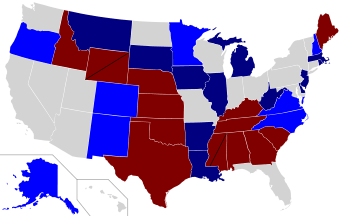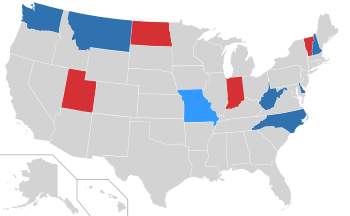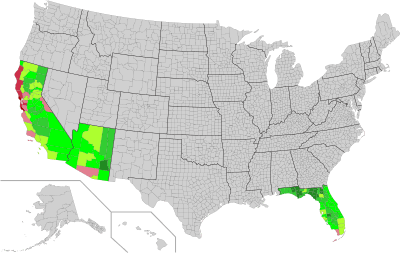United States elections, 2008
| Presidential election year | |
| Election day | November 4 |
|---|---|
| Presidential election | |
| Electoral vote | |
| Barack Obama (D) | 365 |
| John McCain (R) | 173 |
 | |
| 2008 Presidential election results map. Blue denotes states/districts won by Democrat Barack Obama, and Red denotes those won by Republican John McCain. Numbers indicate electoral votes allotted to the winner of each state. Obama won one electoral vote (from Nebraska's 2nd congressional district) of Nebraska's five. | |
| Senate elections | |
| Seats contested | 33 seats of Class II |
| Net change | Democratic +8 |
 | |
| 2008 Senate election results map | |
| House elections | |
| Net change | Democratic +21 |
 | |
| 2008 House election results map | |
| Gubernatorial elections | |
| Seats contested | 13 (11 states, 2 territories) |
| Net change | Democratic +1 |
 | |
| 2008 Gubernatorial election results map | |
| Legend | |
|
Democratic hold Democratic gain Republican hold Republican gain | |
The 2008 United States elections were held on November 4. The result was a significant victory for the Democratic Party on the national level, as they increased majorities in both houses of Congress and won the Presidency. Democratic Senator Barack Obama of Illinois defeated Republican Senator John McCain of Arizona in the presidential election. Riding Obama's coattails, the Democrats also picked up net gains of 8 Senate seats and 21 House seats.
The governorship of 11 states and two U.S. territories were also up for election. Only one of them changed party hands: Democrat Jay Nixon won the Missouri gubernatorial election, replacing Republican Matt Blunt, who decided to retire instead of run for a second term.
The major theme during the campaign was the American public's general desire of change and reform from both Washington and the policies of outgoing Republican President George W. Bush (Bush was term limited out of office per the Twenty-second Amendment to the United States Constitution). The economy and other domestic policies were also dominant issues, especially during the last months of the campaign after the onset of the 2008 economic crisis.
Following the Democrats' victories from 2006, this became the first time in 76 years that the party had two back-to-back Democratic wave elections making substantial gains in Congress. The first was in 1930, followed by 1932.[1][2]
President
Senator Barack Obama of Illinois was the Democratic nominee, and Senator John McCain of Arizona was the Republican nominee. Incumbent President George W. Bush was ineligible for re-election per the 22nd Amendment, which limits a president to two terms, and incumbent Vice President Dick Cheney declined to run for the office.
The 2008 presidential election was the first since 1928 in which neither an incumbent president nor an incumbent vice president was a candidate, and the first since 1952 in which neither was nominated by his party as a candidate in the general election and the first since 1976 in which the incumbent vice-president was not a candidate for president or vice-president.
Senator Obama won the number of electors necessary to be elected President and was inaugurated on January 20, 2009.[3]
United States Senate
The 33 seats in the United States Senate Class 2 were up for election, plus special Senate elections in Mississippi and Wyoming. The resignation of Mississippi Senator Trent Lott, and the death of Wyoming Senator Craig L. Thomas, both Class 1 senators, meant that both of those states' senate seats were up for election. The Democrats won 8 seats while the Republicans did not gain a seat.
United States House of Representatives
All seats in the House were up for election, including seats of the 435 voting representatives from the states and the 6 non-voting delegates from the District of Columbia and five U.S. territories. This marked the first time that the commonwealth of the Northern Mariana Islands selected a delegate to Congress, as per new legislation, Pub.L. 110–229, enacted in May 2008.
Of the 435 voting members of the House, the Democrats gained 21 seats, increasing their majority to 257, their largest since winning in 1992.
Governors
Eleven of the fifty United States governors were up for re-election, as were the governorships of two U.S. territories. Eight incumbent state governors were running for re-election, while the retirements of Ruth Ann Minner of Delaware, Matt Blunt of Missouri, and Mike Easley of North Carolina left those gubernatorial positions open. The incumbent governors of Puerto Rico, Aníbal Acevedo Vilá, and American Samoa, Togiola Tulafono, were also up for re-election.
The only governorship that changed party hands was in Missouri: Democrat Jay Nixon was elected to replace the retiring Republican Blunt.
State legislatures
The New Hampshire Senate saw the election of the first ever female majority. This is first time this has occurred in any chamber of any state legislature in United States history.[4]
The New York State Assembly, New York State Senate, and Governor's mansion were controlled by the Democrats for the first time since the Great Depression.
Overall, the Democrats took control of six legislative bodies to the Republicans' four. Democrats took control of the Delaware House of Representatives, Montana House of Representatives, Nevada Senate, New York State Senate, Ohio House of Representatives, and Wisconsin State Assembly. Republicans took control of the Montana Senate; Oklahoma Senate, for the first time in state history; Tennessee House of Representatives, and Tennessee Senate.
After the election, Democrats controlled both houses in the state legislatures of 27 states: Alabama, Arkansas, California, Colorado, Connecticut, Delaware, Hawaii, Illinois, Iowa, Louisiana, Maine, Maryland, Massachusetts, Minnesota, Mississippi, Nevada, New Hampshire, New Jersey, New Mexico, New York, North Carolina, Oregon, Rhode Island, Vermont, Washington, West Virginia, and Wisconsin.
Republicans controlled both houses in the state legislatures of 14 states: Arizona, Florida, Georgia, Idaho, Kansas, Missouri, North Dakota, Oklahoma, South Carolina, South Dakota, Tennessee, Texas, Utah, and Wyoming.
Eight states had divided legislatures: Alaska, Indiana, Kentucky, Michigan, Montana, Ohio, Pennsylvania, and Virginia.
Nebraska has a unicameral non-partisan legislature.
Initiatives and referenda

- State constitutional amendments prohibiting same-sex marriage are passed in three states: Arizona, California, and Florida. The measures in Arizona and California ban same-sex marriage only, while Florida bans both same-sex marriage and civil unions. California is the first state to ban same-sex marriage after having legalized it previously.
References
- ↑ Barbara Bradley Hagerty & Deborah Tedford (November 4, 2008). "Democrats Poised For Landslide Wins In House". NPR.
- ↑ Matt Bai (June 8, 2010). "Democrat in Chief?". New York Times.
- ↑ "Obama wins historic US election". BBC. November 5, 2008.
- ↑ "New Hampshire Senate Makes History". ABC News. December 7, 2008.
Further reading
- Barreto, Matt A., et al. "“Should They Dance with the One Who Brung'Em?” Latinos and the 2008 Presidential Election." PS: Political Science & Politics (2009) 41#4 pp: 753-760. online
- Bligh, Michelle C., and Jeffrey C. Kohles. "The enduring allure of charisma: How Barack Obama won the historic 2008 presidential election." The Leadership Quarterly (2009) 20#3 pp: 483-492. online
- Campbell, James E. "An exceptional election: Performance, values, and crisis in the 2008 presidential election." The Forum (2009) Vol. 6. No. 4. online
- Crotty, William J. Winning the presidency 2008 (Routledge, 2015).
- Jacobson, Gary C. "The 2008 Presidential and Congressional Elections: Anti‐Bush Referendum and Prospects for the Democratic Majority." Political Science Quarterly (2009) 124#1 pp: 1-30. online
- Panagopoulos, Costas, ed. Strategy, Money and Technology in the 2008 Presidential Election (Routledge, 2014).
External links
- United States Election 2008 Web Archive from the U.S. Library of Congress